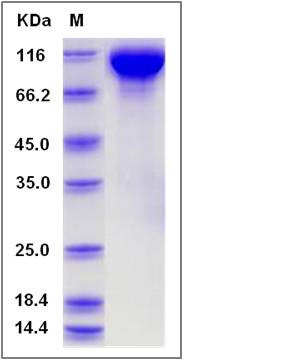Rat EGFR / HER1 / ErbB1 Protein (His Tag)
EGFR
- 100ug (NPP1248) Please inquiry
| Catalog Number | P80100-R08H |
|---|---|
| Organism Species | Rat |
| Host | Human Cells |
| Synonyms | EGFR |
| Molecular Weight | The recombinant rat EGFR comprises 633 amino acids and predicts a molecular mass of 70.7 kDa. The apparent molecular mass of the recombinant protein is approximately 93-110 kDa in SDS-PAGE under reducing conditions due to glycosylation. |
| predicted N | Leu 25 |
| SDS-PAGE |  |
| Purity | > 98 % as determined by SDS-PAGE |
| Protein Construction | A DNA sequence encoding the rat EGFR (E7CXR8) (Met1-Ser646) was expressed, fused with a polyhistidine tag at the C-terminus. |
| Bio-activity | |
| Research Area | Signaling |Signal Transduction |Protein Phosphorylation |Tyrosine Kinase |Receptor Tyrosine Kinases |
| Formulation | Lyophilized from sterile PBS, pH 7.4 1. Normally 5 % - 8 % trehalose, mannitol and 0.01% Tween80 are added as protectants before lyophilization. Specific concentrations are included in the hardcopy of COA. |
| Background | As a member of the epidermal growth factor receptor (EGFR) family, EGFR protein is type I transmembrane glycoprotein that binds a subset of EGF family ligands including EGF, amphiregulin, TGF-α, betacellulin, etc. EGFR protein plays a crucial role in signaling pathway in the regulation of cell proliferation, survival and differentiation. Binding of a ligand induces EGFR protein homo- or heterodimerization, the subsequent tyrosine autophosphorylation and initiates various down stream pathways (MAPK, PI3K/PKB and STAT). In addition, EGFR signaling also has been shown to exert action on carcinogenesis and disease progression, and thus EGFR protein is proposed as a target for cancer therapy currently. |
| Reference |
